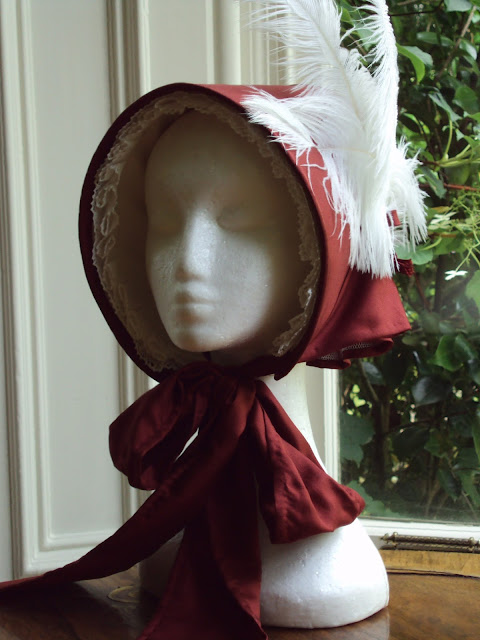6 days to go and I think, fingers crossed, that Victoria's wardrobe is more or less finished.There are one or two little finishing jobs to see to, but all of the main garments are now complete.
The last item to be finished was a bonnet for wearing to day time events.
Bonnets were an essential part of 19th century women's dress. They dominated millinery fashions throughout the first half of the century and were often regarded as emblematic of the ideals of Victorian womanhood: respectability, virtue, delicacy, authenticity and domesticity.* A woman could not leave the house with her head uncovered and bonnets were the most fashionable and most conventional choice of headwear.
Although the Queen would have worn a crown or tiara for state occasions and evening events, during the day she too wore bonnets. Unfortunately, there are very few early portraits of the Queen in everyday dress as most paintings depicted her in her robes of state, her wedding dress, or regalia. However, this 1856 portrait by Charles Lucien-Louis Muller depicts the Queen in a simple red day gown and white bonnet with ostrich feathers.
 |
| Queen Victoria, 1856, Charles Lucien Louis Muller (image found here) |
There are also a number of the Queen's bonnets in the Royal Collections at the Museum of London, including a straw bonnet decorated with deep red ribbons.
 |
| "These are the only known examples of Queen Victoria's bonnets from before 1861" - Bonnets, 1845-1855 , Museum of London (Mol.66.79/16,17,18) |
Taking inspiration from the colour combinations in the portrait and extant bonnets, I chose a deep red silk twill that complements the red and gold silk gown for my bonnet with white lace and ostrich feather trimmings. The bonnet has the typical form of 1840s bonnets: a close fitting round brim framing the face and an almost horizontal line from the round crown to the brim, tied close under the chin. In the early 1840s, the brim extended forwards, hiding the wearer's profile, but towards the decade began to slip back to reveal more of the the hair and cheek.
The interior of the bonnet is trimmed with a lace ruffle that nestles around the face when worn. This will complete Victoria's outfits for daytime wear when out and about in town.
* References
Joanne Sullivan,
"Bonnet Ribbons: A study of the use and representation of silk ribbons as ties on fashionable bonnets, 1830-1899", (Masters Dissertation, University of Glasgow, 2015)
Joan Nunn,
Fashion in Costume 1200-1980, (London: The Herbert Press, 1984), 124.
Susan Hiner,
Accessories to Modernity: Fashion and the Feminine in Nineteenth-Century France, (Philadelphia and Oxford: University of Pennsylvania Press, 2010), 3.


























